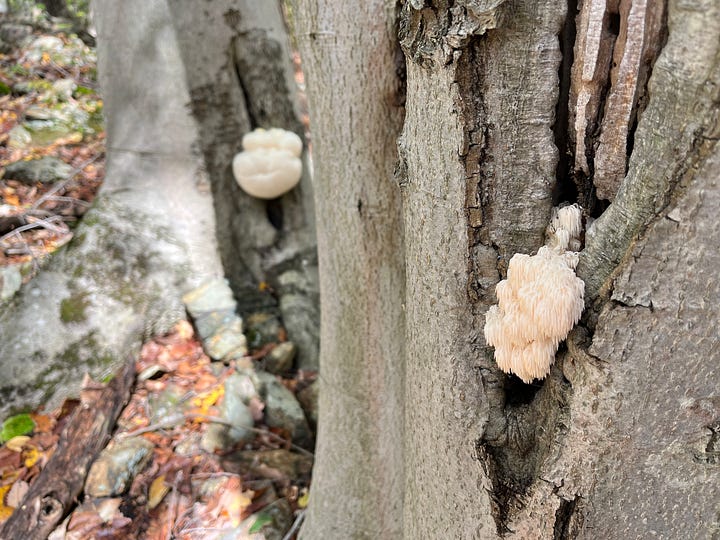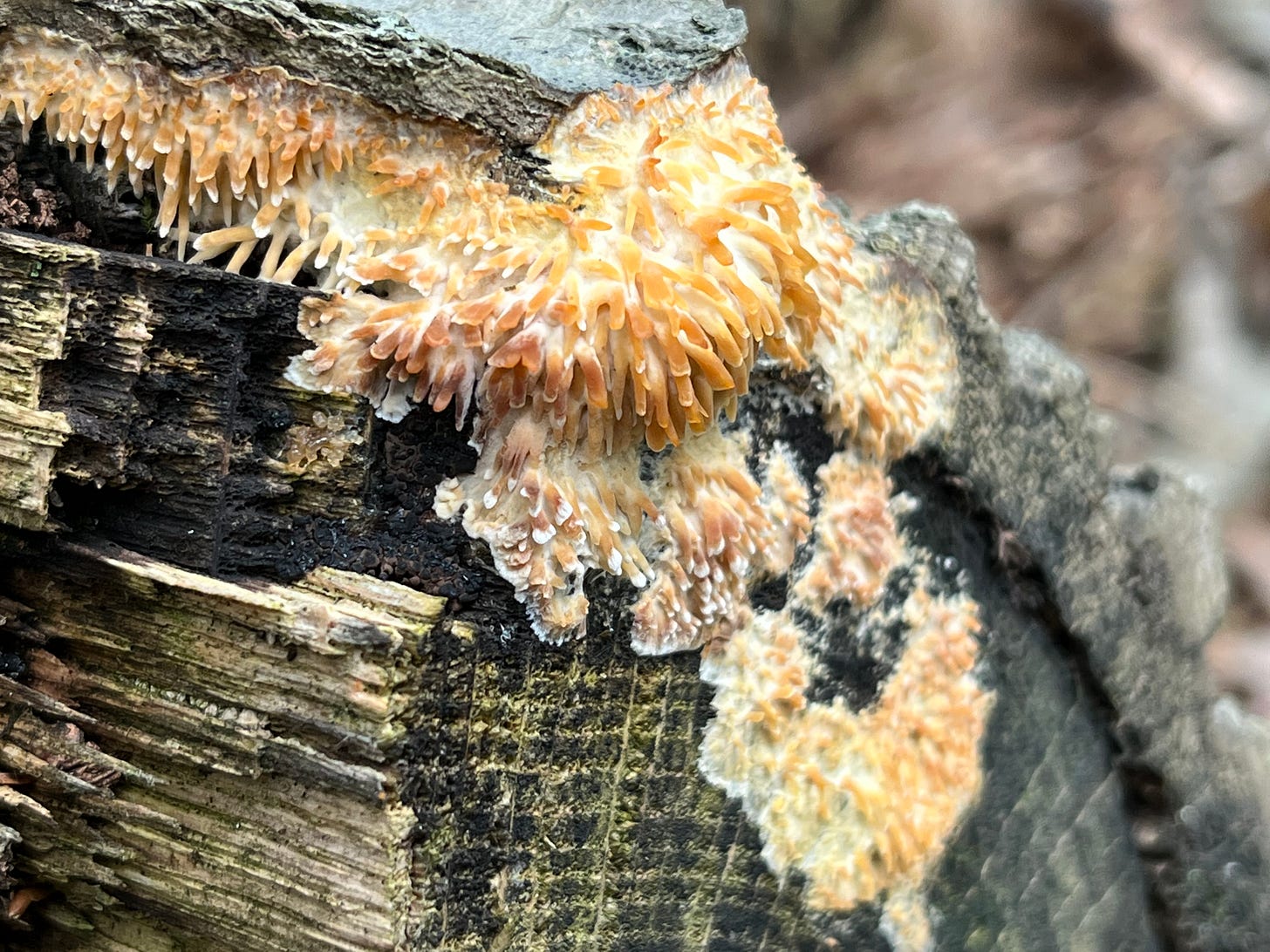Good evening, friends,
This week’s mushroom is the Asian Beauty (Radulomyces Copelandii). Bit of a weird common name when I say it out loud on mushroom walks, but I always like to push through the awkwardness by spewing the latin name to confuse people and bury it. Curiously, this fungus is native to Asia and just started popping up in North America within the past fifteen years. I’ve had people ask me if this is the medicinal and edible Lion’s Mane (Hericium erinaceus), which it is not, but they grow around the same time so it’s good to be familiar with both of them. Let’s see if we can’t learn a little more about this mushroom’s prolific rise to prominence in North American forests.
Fun Facts
This fungus was first seen outside of Asia in Bradley Palmer State Park in Ipswich, Massachusetts by Lawrence (Larry) Millman in 2009 (Reference 3). This was the first documented sighting of the fungus in North America, but just one year later Larry was seeing the fungus on every mushroom collecting trip he took. By 2011, although the fungus was quite prevalent in Massachusetts, all the sightings were still within a 35 mile radius of Boston.
A touch over ten years later and that is no longer the case. Thomas Roehl of Fungus Fact Friday roughly calculated the spread of the fungus emanating out of the Boston area at 67 miles per year (Reference 4). That seems like a conservative estimate. R. copelandii can now be found up and down the east coast, stretching inland to Kansas and Iowa, and also on the other side of the Rockies from California up through the PNW. An incredibly rapid spread that we can’t hope to control, we can only go to the woods and watch.
It’s believed that the fungus was introduced by anthropogenic (human) means and is probably the most aggressive, invasive fungus we know about in North America. The means of introduction are unknown, and unfortunately I didn’t read any good hypotheses as to how the fungus got here. It was noted that plants shipped over from Asia were introduced in Bradley Palmer State Park 100 years earlier. However, the lack of sightings until recently and the subsequent rapid spread of the fungus would indicate it was introduced this millennium. In large flushes you can see the white spores released from the mushroom in clouds, and that prolific spore dispersal may be one reason the fungus spreads so quickly. My question is what took it so long to get here?

The other invasive fungus I’ve written about is the Golden Oyster (Pleurotus citrinopileatus) which was brought over to grow for culinary purposes, escaped cultivation, and now grows throughout the Great Lakes region and into New England. The two species of invasive fungi are occupying ecological niches of native species, and possibly pushing them out - but the entire ecological impacts of invasive fungi aren’t nearly as well understood as those of invasive plants. Below, I’m including an excerpt from the golden oysters MM about invasive species and biodiversity if you’re unfamiliar with the concepts (slightly modified to keep with the context):
“The idea of invasive species can be a controversial one in ecology. At the preserve where I work (Manitou Point Preserve), we plant native plants and remove invasive plants to help increase biodiversity (the diversity across all kingdoms of life in an ecosystem). Some plants are not native to the area but also aren’t invasive because they do not reproduce aggressively and compete with native species for resources (light, water, space).
However, the fact that the earth is so interconnected, and humans ourselves aren’t necessarily “native” to where we live, make some dismiss the idea of strictly planting native plant species. I’m of the belief that we want a wide array of flora, fauna, and funga because this diversity of life creates a more resilient and healthy ecosystem.
Left to their own devices, Japanese knotweed (Reynoutria japonica) and Mugwort (Artemesia vulgaris) would create plant monocultures in areas of the preserve (as they have in many disturbed landscapes throughout the country). These monocultures severely limit the diversity, quantity, and quality of life both above and below ground.
Ecology
The fungus is saprobic (decomposes dead organic material) on hardwoods like oaks and maples. The mushrooms have a penchant for growing in the grooves of bark where it is known to be moister and perhaps a little more sheltered from the elements. R. copelandii is considered a crust fungus because it grows resupinate (flat) on whichever substrate it is digesting. The needle-like teeth will grow to about a centimeter in length and the fungus can stretch for feet up and down the grooves of the bark.
As previously noted, the range increase from Asia to a majority of North America was rather recent, and there are now even recordings from Central America. The mushroom can grow year-round but seems to prefer the cooler temps of the fall in the northeast - although I found this fungus twice in August. The teeth start white but fade to yellow before turning brown. The spores are also white.
There are a couple key characteristics to help you identify this fungus and differentiate it from Lions Mane or other look-a-likes. R. copelandii possesses a subiculum - a thin membrane - which attaches the fungus to the wood and out of which the teeth grow. Lion’s Mane (Hericium erinaceus) and the other Hericium species project off the wood (are not resupinate) and can form large mushrooms the size of my head. You may also want to compare your specimens with Mycoacia fuscoatra and species of Mucronella. If you want a more comprehensive list of similar species, check out Reference 3.


Mushroom Monday Housekeeping & Book Report
As I noted last week, Mushroom Monday will not go out in December because I’ll be using the time to read and write a book report on The Sacred Mushroom and the Cross. There was some confusion on my end about post limits and whether I need to turn on payments to get an unlimited word count. After some light googling I discovered that Substack doesn’t impose a word limit. They may hit us with a “Post too long” if a post surpasses 102KB (the size at which email providers, like Gmail, will truncate messages), but it looks like we can bulldoze through that. Worst case we may just have to read the full report on Substack’s website instead of in an email browser.
I may open up the payments at some point this winter if I feel like it, at which point people that have “pledged” support financially (none more-so than my mom, thank you mom) will be charged. I will notify these folks individually before I do that so there won’t be any mystery charges. As of right now, though, we’re all good and no one needs to do anything. Just how I like it.
Have a great Thanksgiving - hope you encounter lots of Turkey Tail ;),
Aubrey
References
Kuo, M. (2022, March). Radulomyces copelandii. Retrieved from the MushroomExpert.Com Web site: http://www.mushroomexpert.com/radulomyces_copelandii.html
https://www.fungimag.com/summer-2011-articles/FungiSUM_AsianBeautyLR.pdf
https://www.inaturalist.org/taxa/1113584-Radulomyces-copelandii








